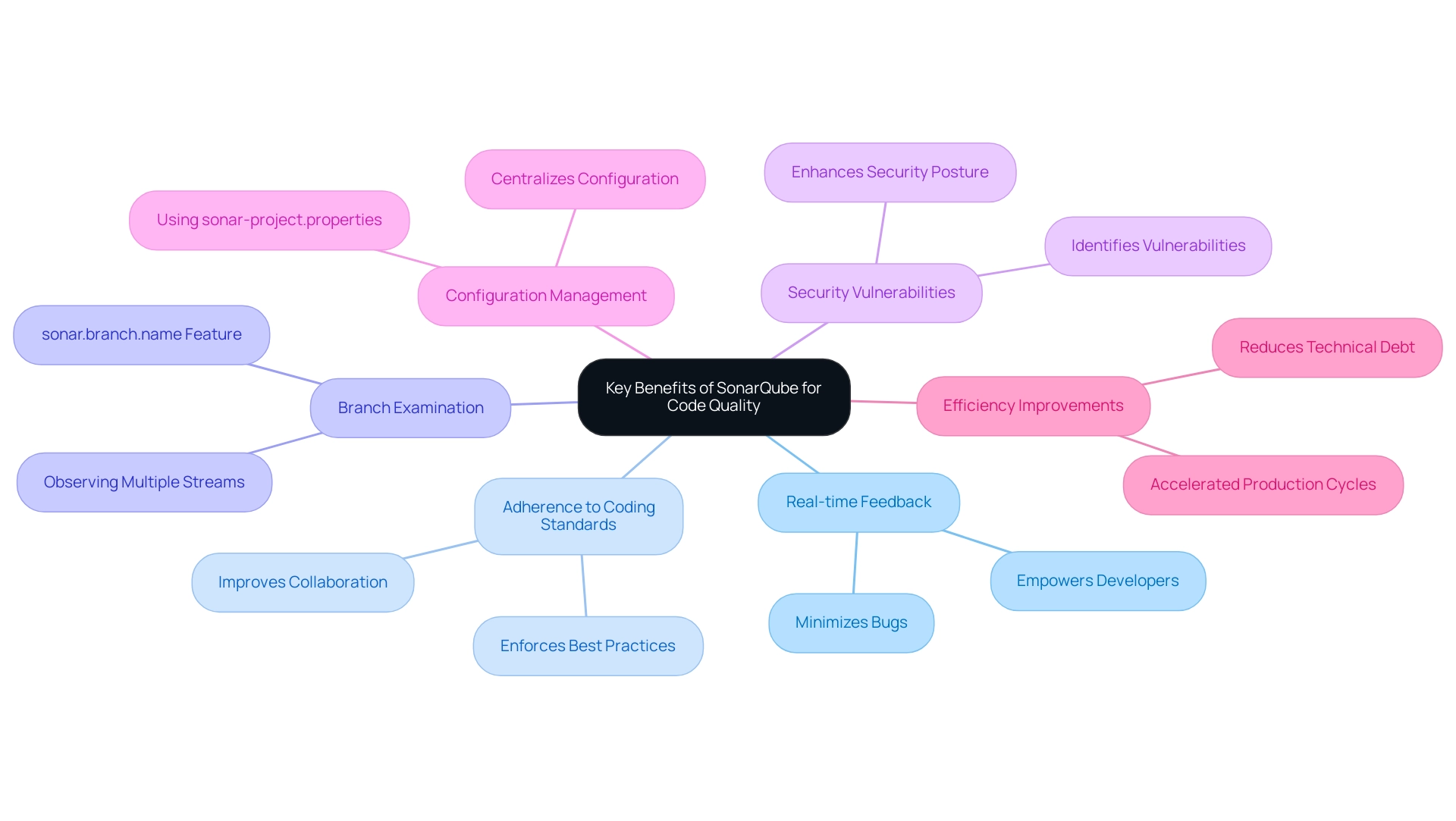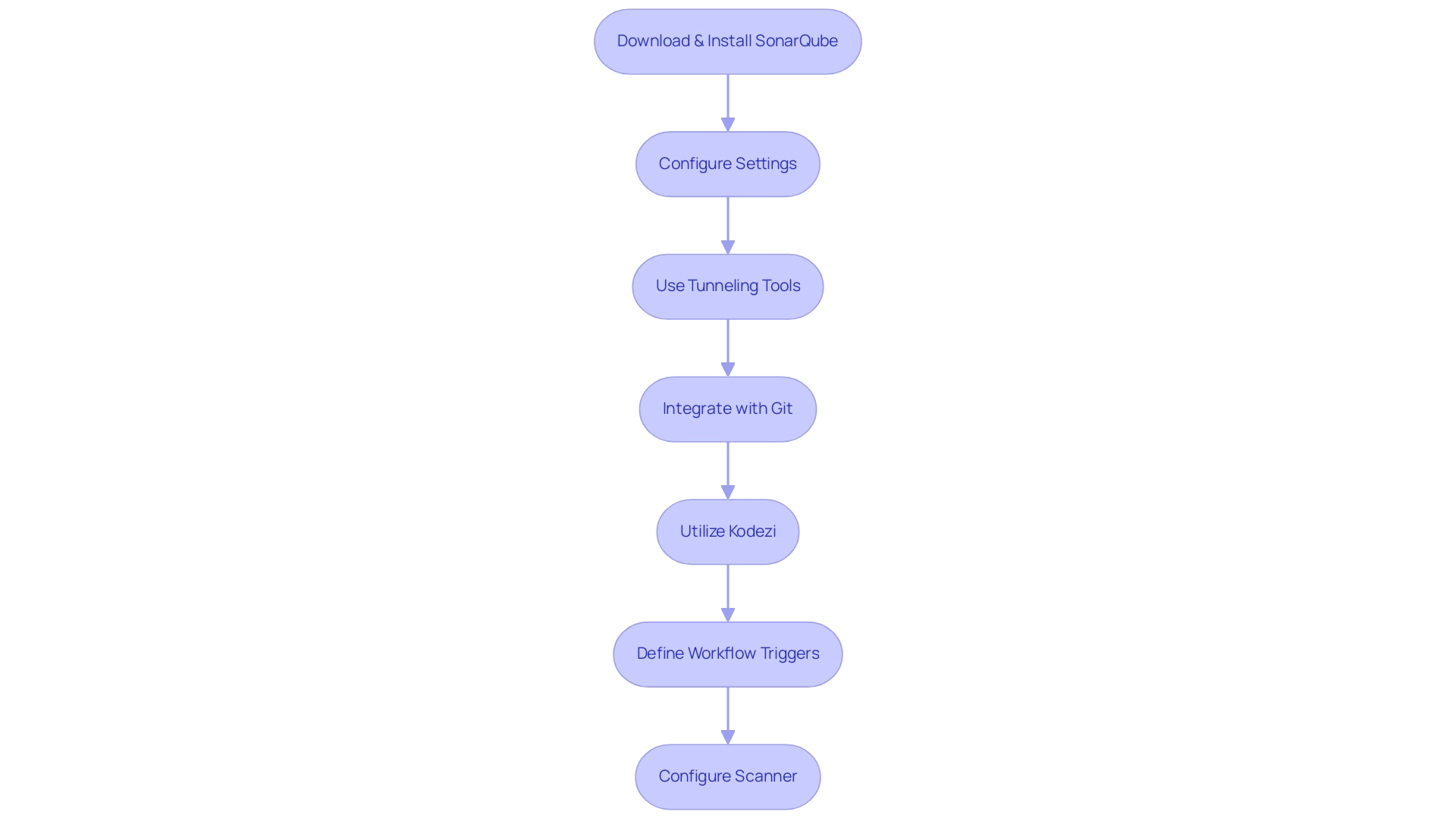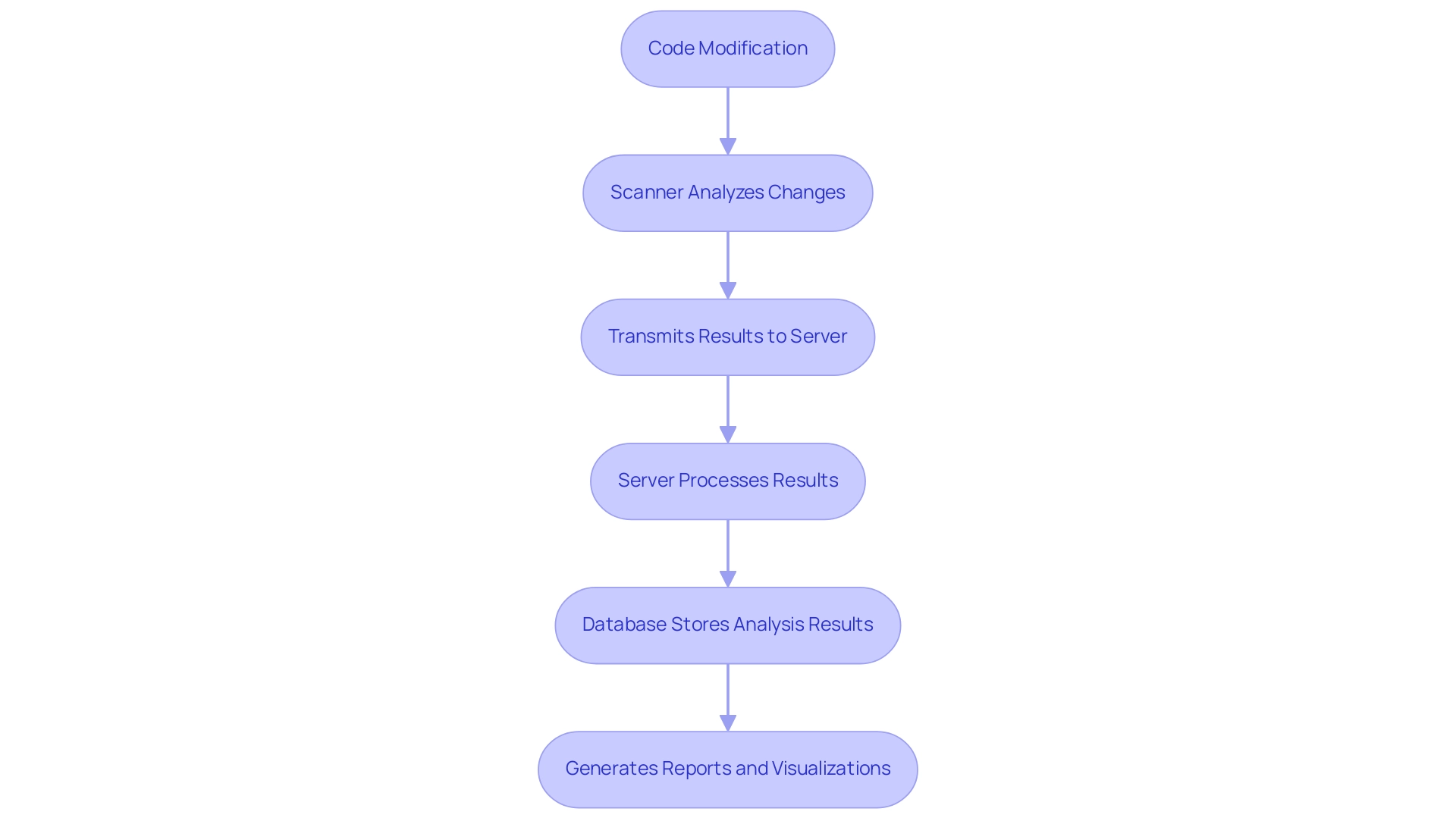Introduction
In the realm of software development, ensuring code quality is paramount to delivering reliable and secure applications. SonarQube emerges as a powerful ally for development teams, providing an open-source solution designed to continuously inspect and enhance code quality. With its ability to swiftly identify vulnerabilities, bugs, and code smells, SonarQube not only empowers teams to maintain high software standards but also integrates seamlessly into existing workflows.
This article delves into the numerous benefits and features of SonarQube, highlighting how it streamlines code management, enhances collaboration, and ultimately drives productivity. By understanding its architecture and integration capabilities, teams can unlock the full potential of SonarQube, paving the way for efficient and effective software development practices.
Understanding SonarQube: Definition and Purpose
The open-source platform is designed for the ongoing assessment of quality and security in applications. Its primary objective is to enable groups in overseeing quality by quickly detecting vulnerabilities, flaws, and design issues within the software repository. With the new benchmark for coverage established at no less than 80%, the tool ensures that developers uphold high software quality standards, enabling applications to be both functional and secure over time.
The tool integrates seamlessly into development workflows, allowing teams to detect issues early in the software development lifecycle, significantly reducing technical debt and enhancing overall project outcomes. Automated debugging features within the platform enable swift issue resolution, performance enhancement, and security adherence, strengthening best practices in programming standards. Users can instantly identify and fix codebase issues while viewing detailed explanations and insights into what went wrong and how it was resolved.
Additionally, the tool assists in resolving performance bottlenecks, identifying security issues, incorporating exception handling, and improving code formatting in any section of the codebase in seconds. Connected Mode in the tool for IDE provides advanced capabilities when paired with the Server, offering instant code-quality feedback that enhances the coding experience. Furthermore, recent benchmarking reports indicate that there are objectively better and more modern metrics available, such as CodeScene's Code Health metric, which surpasses the maintainability rating of its competitor.
This highlights the significance of utilizing modern tools for optimal results in quality management, empowering teams to attain maximum efficiency and productivity.
Key Benefits of Using SonarQube for Code Quality
This tool provides a variety of benefits for efficient quality management of software. One of its standout features is the provision of real-time feedback on programming quality, empowering developers to tackle issues as they emerge. This proactive strategy minimizes the risk of bugs reaching production environments, thereby safeguarding the integrity of the final product.
Additionally, the tool promotes adherence to best coding practices by enforcing established coding standards and guidelines, which improves collaboration and ensures consistency across different codebases. Significantly, the Developer Edition of Sonar permits the examination of various branches through sonar.branch.name, further improving quality management by allowing groups to observe and resolve issues across multiple project streams. Additionally, it plays a critical role in identifying security vulnerabilities, significantly bolstering the application's overall security posture.
A practical example of this is demonstrated in a case study where groups utilized the sonar-project.properties file for configuration, which enhanced script readability and maintainability by centralizing configuration settings. By effortlessly incorporating the tool into their workflow, groups can significantly lessen technical debt and enhance the maintainability of their code.
This integration results in accelerated production cycles and the delivery of higher-quality software products. As Maryna Prudka, an R&D Delivery Manager, emphasizes, "This tool allows our group to handle requests efficiently and react quickly, greatly influencing project results." This dedication to efficiency and responsiveness demonstrates the transformative effect that this tool can have on software projects, allowing groups to attain optimal results.

Exploring the Features of SonarQube
SonarQube, what is it? It offers a comprehensive set of features that significantly enhance quality management, which is essential for agile processes. Central to its capabilities is automated debugging, which enables groups to instantly identify and resolve codebase problems while providing detailed explanations and insights into the errors and their solutions. This proactive strategy reduces expensive repairs by tackling potential weaknesses early in the creation phase, thus reinforcing security best practices and programming standards.
The platform's advanced static analysis not only identifies performance bottlenecks but also improves formatting and incorporates exception handling throughout any section of your software in seconds. Its comprehensive dashboard displays essential software quality metrics, enabling groups to track progress efficiently and optimize workflows across various programming languages within a cohesive structure. Furthermore, it effortlessly connects with well-known CI/CD tools, allowing automated software analysis as a crucial component of the build process.
This integration guarantees systematic application of quality assessments, fostering a culture of excellence within programming groups. With the ability to examine code alterations for projects containing up to 1 million lines of code in as little as 5 minutes, teams can reach extraordinary efficiency and uphold high-quality standards.
As emphasized by Romina Mendez, a Data Architect and University Professor, the role of static code analysis tools, specifically SonarQube, is essential in enhancing software creation processes, highlighting the significance of automated testing in attaining successful project results. Upgrading to SonarQube Server Enterprise Edition can further accelerate mission-critical software creation, providing additional features and tailored support for larger organizations. The preliminary evaluation of a project determines its overall condition, with analysis durations differing according to project size, enabling users to interact with the latest updates on the platform effectively.
Additionally, the emphasis on enforcing security best practices and coding standards ensures that the codebase remains compliant and secure throughout the development lifecycle.
Setting Up and Integrating SonarQube in Your Workflow
Establishing the tool effectively involves several key steps that can significantly enhance code quality and team productivity. Initially, users must download and install the server, tailoring the configuration to meet specific project requirements. Additionally, to expose a local instance of the software to the internet, users can utilize tunneling tools like Localtunnel, which requires Node.js to be installed.
Following installation, integrating SonarQube with version control systems such as Git is essential for automating analysis during changes, leading to developers receiving immediate feedback on quality, which prompts the inquiry: sonarqube what is it? Here, Kodezi steps in as an AI-driven programming tool that automatically analyzes bugs, corrects scripts, and optimizes the programming process, streamlining the workflow. Kodezi distinguishes itself from rivals such as Copilot by emphasizing automatic debugging and correction instead of simply auto filling text.
This integration was demonstrated in a case study where the IDE extension for quality assessment was used in Visual Studio Code, leading to improved standards before repository commits. Furthermore, the workflow file sonarqube.yml defines triggers for push and pull_request events, which highlights sonarqube what is it in the context of automation within the integration. Another critical step is configuring the scanner, which facilitates comprehensive analysis of the codebase throughout the build process.
To enhance this integration, groups should set clear guidelines indicating when and how to carry out analyses, ensuring a consistent approach to maintaining high quality of programming. Kodezi currently supports over 30 programming languages and is compatible with Visual Studio Code, with plans for future IDE support. By utilizing Kodezi alongside another tool, teams can establish a strong workflow that effortlessly integrates advanced AI-driven features, ultimately enhancing results and efficiency in their development processes.
Kodezi offers both free and paid plans, making it accessible for programmers at all levels, from beginners to enterprises looking to enhance productivity.

The Architecture of SonarQube: How It Works
The platform utilizes a strong client-server structure that enhances the analysis of software through a dedicated server hosting the analysis engine and a database for storing analysis results. Upon pushing modifications, the scanner efficiently analyzes the changes, swiftly identifying and rectifying issues, and transmits the results to the server for processing and storage. This streamlined process not only enables instant issue resolution but also enhances performance optimization and security compliance across your codebase.
SonarQube enables users to resolve performance bottlenecks, identify security issues, incorporate exception handling, and improve formatting in any section of their codebase in seconds. The server subsequently generates insightful reports and visualizations detailing critical code quality metrics, including code coverage, duplications, and technical debt. Such capabilities empower teams to manage their codebases effectively, ensuring adherence to the latest security best practices and coding standards.
Notably, 95% of medium, large, and extra-large project sizes are analyzed within established targets on the cloud platform, demonstrating its capability to handle substantial workloads. However, as Alexandre Gigleux, Product Manager, notes, 'For XS and S, we are not on track mainly because of the time to start the analysis.' This highlights the ongoing challenges in optimizing performance for smaller project sizes.
By understanding the intricacies of the operational framework, developers can harness its full potential to significantly improve their development processes, particularly in the context of automated reviews and API documentation synchronization, which relates to SonarQube. Furthermore, when issues are identified, the tool offers detailed explanations and insights into what went wrong and how it was resolved, which is crucial for rapid issue resolution. The development of programming analysis instruments is essential as the industry advances into 2024, and the architecture of this tool plays a vital role in this progression.
For instance, the introduction of the ability to analyze only changed files in pull requests with SonarQube version 9.3 exemplifies how its architecture can improve analysis times for various languages, although the overall code change analysis duration targets have not yet been fully met.

Conclusion
SonarQube stands out as a crucial tool in the software development landscape, offering a comprehensive solution for code quality and security management. By providing real-time feedback, automated debugging, and seamless integration with existing workflows, it empowers development teams to proactively address vulnerabilities and maintain high coding standards. The platform's architecture facilitates efficient code analysis, enabling teams to swiftly identify and rectify issues, which ultimately leads to reduced technical debt and optimized performance.
The numerous benefits of utilizing SonarQube extend beyond mere code inspection; they foster a culture of collaboration and excellence within development teams. By adhering to best practices and leveraging advanced features, such as static code analysis and integration with CI/CD tools, teams can enhance their productivity and deliver high-quality software products more efficiently. The positive impact of SonarQube is further underscored by real-world success stories, illustrating its transformative role in optimizing development processes.
In conclusion, embracing SonarQube not only streamlines code quality management but also significantly boosts overall project outcomes. As the software industry continues to evolve, the integration of such powerful tools becomes essential for teams aiming to achieve maximum efficiency and productivity. The commitment to maintaining high standards in code quality will undoubtedly pave the way for more reliable and secure applications in the future.
Frequently Asked Questions
What is the primary objective of the open-source platform mentioned in the article?
The primary objective of the open-source platform is to enable groups to oversee quality by quickly detecting vulnerabilities, flaws, and design issues within the software repository.
What is the established benchmark for coverage in the tool?
The established benchmark for coverage in the tool is no less than 80%.
How does the tool enhance quality management in software development?
The tool integrates seamlessly into development workflows, allowing teams to detect issues early in the software development lifecycle, which significantly reduces technical debt and enhances overall project outcomes.
What automated features does the platform provide?
The platform provides automated debugging features that enable swift issue resolution, performance enhancement, and security adherence, strengthening best practices in programming standards.
What capabilities does the Connected Mode in the tool offer?
The Connected Mode in the tool for IDE provides advanced capabilities when paired with the Server, offering instant code-quality feedback that enhances the coding experience.
How does the tool assist in managing security vulnerabilities?
The tool plays a critical role in identifying security vulnerabilities, significantly bolstering the application's overall security posture.
What is the significance of the Developer Edition of Sonar?
The Developer Edition of Sonar allows the examination of various branches through sonar.branch.name, improving quality management by enabling groups to observe and resolve issues across multiple project streams.
How does the integration of the tool affect production cycles?
The integration of the tool results in accelerated production cycles and the delivery of higher-quality software products.
Can you provide an example of how the tool improves script readability and maintainability?
A practical example is the use of the sonar-project.properties file for configuration, which enhances script readability and maintainability by centralizing configuration settings.
What impact does the tool have on project results according to Maryna Prudka?
According to Maryna Prudka, the tool allows groups to handle requests efficiently and react quickly, greatly influencing project results.




